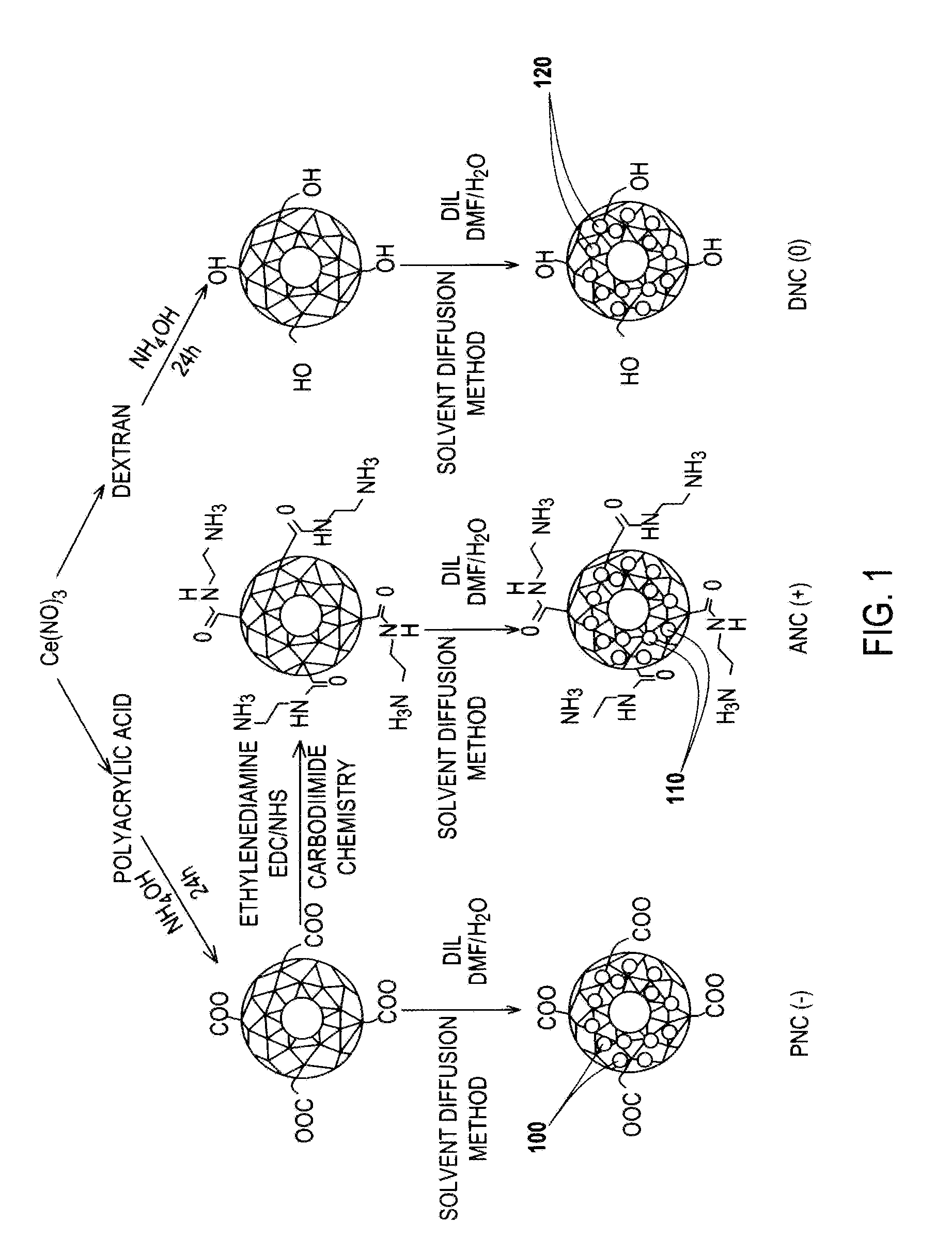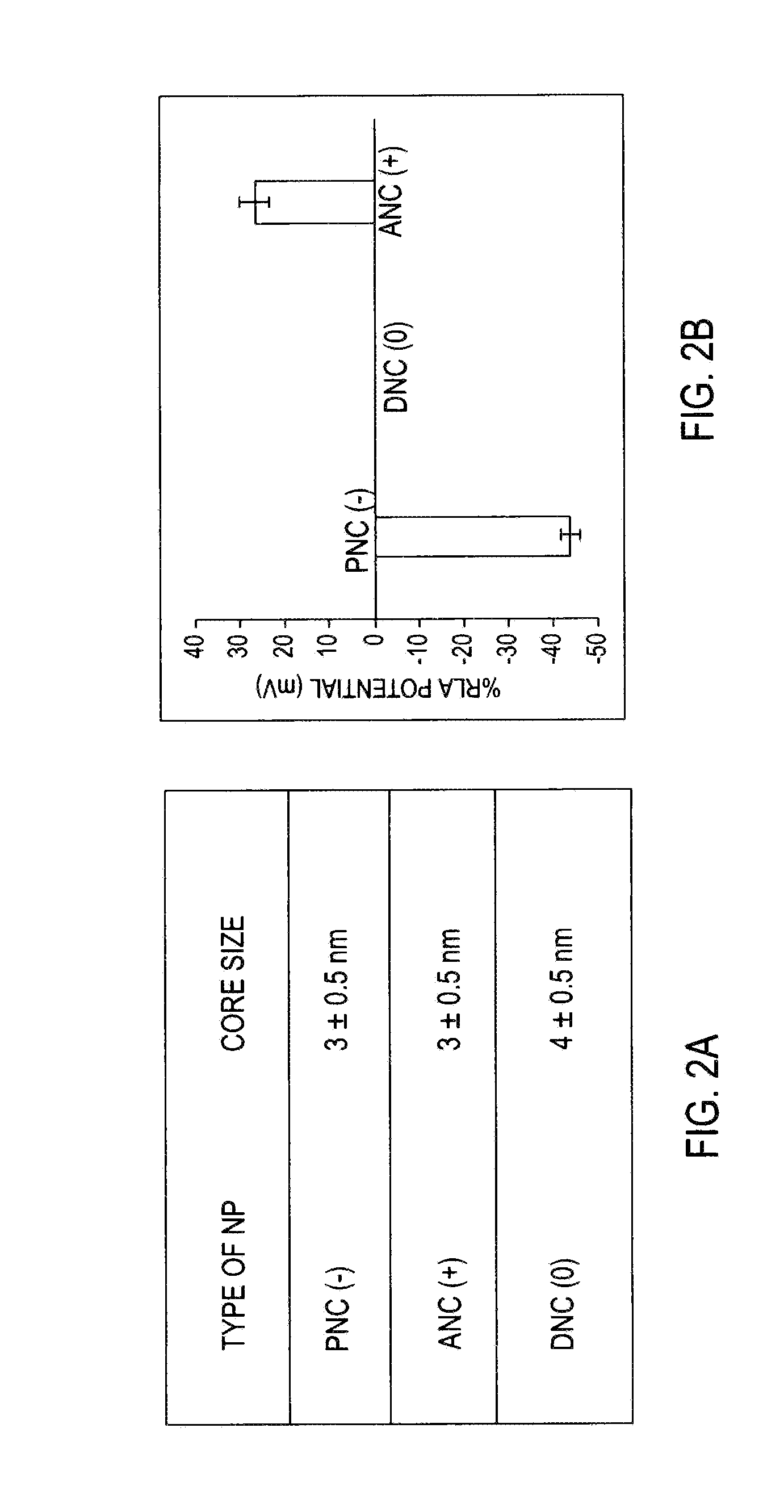Application Device for Inducing Cytotoxicity to Tumor Cells Via Coated Cerium Oxide Nanoparticles
a cerium oxide nanoparticle and tumor cell technology, applied in the field of human and animal cell treatment, can solve the problems of nanomaterials and living systems that can be potentially harmful, silver nanoparticles have been found to display size-dependent toxicity, and the greatest liability of nanomaterials, etc., and achieve the effect of no toxicity
- Summary
- Abstract
- Description
- Claims
- Application Information
AI Technical Summary
Benefits of technology
Problems solved by technology
Method used
Image
Examples
example 1
Synthesis and Characterization of Polymer-Coated Cerium Oxide Nanoparticles
[0092]FIG. 1 is an illustration of various nanoceria preparations coated with either polyacrylic acid (PNC), aminated polyacrylic acid (ANC), or dextran (DNC) that endow nanoparticles with a negative (−), positive (+) or neutral (0) surface charge, respectively.
[0093]During synthesis, the nanoparticles were labeled fluorescently, by encapsulating a dye (DiI) 100, 110, 120 within the hydrophobic microdomains of the polymeric coatings of each nanoceria preparation, following a previously reported solvent diffusion methodology disclosed by S. Santra in Drug / dye-loaded, Multifunctional Iron oxide Nanoparticles for Combined Targeted Cancer Therapy and Dual Optical / Magnetic Resonance Imaging, Small 2009, 5, 1862-1868.
[0094]Transmission electron microscopy (TEM) studies reported in FIG. 2A show the presence of nanoparticles of similar core size (3 to 4 nm) in all preparations as reported by A. Asati, et al., in Ange...
example 3
Surface-Charge-Dependent Cellular Interaction of Nanoceria
[0098]Confocal microscopy experiments were performed in order to study the cellular uptake and intracellular localizaton of the DiI-labeled polymer-coated nanoceria. In these experiments, PNC (−), ANC (+) and DNC (0) (1.0 mM) were incubated with two transformed carcinoma cell lines (A549 lung and MCF-7 breast carcinomas), and two non-transformed (normal) cell lines (H9c2 cardiac myocytes and HEK293 human embryonic kidney cells). These cells lines were selected in order to investigate whether there is a difference in uptake by ANC(+), PNC(−) and DNC(0) polymer-coated nanoparticles, thus potentially displaying different toxicity profiles.
[0099]First, the internalization pattern of ANC(+), PNC(−) and DNC(0) was studied in normal cardiac myocyte cells (H9c2), using 10,000 cells as shown in FIGS. 3A-3C. After a 3-hour incubation, results showed that the negatively charged carboxylated nanoparticles [PNC(−)] were minimally uptaken ...
example 4
Internalization Experiments with Cancer Cells
[0102]FIGS. 4A-4C show results of internalization experiments performed with cancer cells (10,000 cells) derived from lung (A549) carcinoma cells. PNC(−) uptake by the A549 cells is minimal or slight as shown in FIG. 4A. In FIG. 4B, lung (A549) carcinoma cells were able to uptake ANC (+); interestingly, a higher degree of internalization and pronounced punctuated fluorescence was observed with the ANC(+) in the A549 cells. This might indicate that in these cells the majority of the ANC(+) localized into endosomal compartments. In contrast, in FIG. 4C, minimal and diffused intracellular fluorescence was observed with the DNC (0) in the A549 cells, suggesting that these nanoparticles are mostly localized in the cytosol with a small fraction confined within the endosomal compartments. Taken together, the above results suggest that the surface charge on polymer-coated nanoceria dictates their differential internalization and localization in n...
PUM
| Property | Measurement | Unit |
|---|---|---|
| Cytotoxicity | aaaaa | aaaaa |
| Toxicity | aaaaa | aaaaa |
| Surface charge | aaaaa | aaaaa |
Abstract
Description
Claims
Application Information
 Login to View More
Login to View More - R&D
- Intellectual Property
- Life Sciences
- Materials
- Tech Scout
- Unparalleled Data Quality
- Higher Quality Content
- 60% Fewer Hallucinations
Browse by: Latest US Patents, China's latest patents, Technical Efficacy Thesaurus, Application Domain, Technology Topic, Popular Technical Reports.
© 2025 PatSnap. All rights reserved.Legal|Privacy policy|Modern Slavery Act Transparency Statement|Sitemap|About US| Contact US: help@patsnap.com



